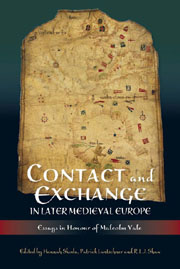Book contents
- Frontmatter
- Contents
- List of Illustrations
- List of Contributors
- Acknowledgements
- The Work of Malcolm Vale
- Principal Bibliography of Malcolm Vale
- Introduction
- Part I Boundaries and Units
- Part II Practices of Exchange
- Introduction
- In and Out of Africa: Iberian Courts and the Afro-Portuguese Olifant of the Late 1400s
- The Knowledge and Use of the ‘Teachings of Saint Louis’ in Fourteenth-Century England
- Philip of Chieti in Flanders, 1303–1305
- The Last Week of the Life of Edward the Black Prince
- Tournament Culture in the Low Countries and England
- Conclusions
- Index
- Tabula Gratulatoria
Tournament Culture in the Low Countries and England
from Part II - Practices of Exchange
Published online by Cambridge University Press: 05 February 2013
- Frontmatter
- Contents
- List of Illustrations
- List of Contributors
- Acknowledgements
- The Work of Malcolm Vale
- Principal Bibliography of Malcolm Vale
- Introduction
- Part I Boundaries and Units
- Part II Practices of Exchange
- Introduction
- In and Out of Africa: Iberian Courts and the Afro-Portuguese Olifant of the Late 1400s
- The Knowledge and Use of the ‘Teachings of Saint Louis’ in Fourteenth-Century England
- Philip of Chieti in Flanders, 1303–1305
- The Last Week of the Life of Edward the Black Prince
- Tournament Culture in the Low Countries and England
- Conclusions
- Index
- Tabula Gratulatoria
Summary
In 1279 John I, duke of Brabant, travelled to England to arrange a marriage for his son with Margaret, daughter of King Edward I. According to the chronicler Jan van Heelu the duke deliberately sought out tournaments and chivalric games (tornoy ende feeste) and he was not disappointed. A tournament was arranged, probably at Windsor, with the royal couple as the most important spectators. But when the time came to divide the teams, it emerged that the duke's conroi was short of a few tourneyers. Then Queen Eleanor of Castile decided that six bannerets, ‘the best of the entire country’, probably with their retinues, should join the duke's team. However, according to Van Heelu, it was commonly known that one could not beat the duke of Brabant even without equal numbers. After the tournament ‘young and old, both knights and heralds’ spoke of the duke's performance and his chivalric deeds, all of which increased his honour and prestige and finally produced the marriage alliance to which he aspired. The marriage was concluded in July 1290 and was preceded again by a big tournament, probably a Round Table, this time at Winchester and with the participation of Edward's prospective son-in-law, the future John II of Brabant, who by then had already been staying at Edward's court for five years. John I died at a tournament in Barle- Duc in 1294, organised on the occasion of the marriage of the duke of Bar with Eleanor, another daughter of Edward I.
- Type
- Chapter
- Information
- Contact and Exchange in Later Medieval EuropeEssays in Honour of Malcolm Vale, pp. 247 - 266Publisher: Boydell & BrewerPrint publication year: 2012



